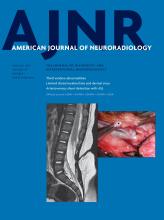Abstract
BACKGROUND AND PURPOSE: The TICI score is widely used to evaluate cerebral perfusion before and after the endovascular treatment of stroke. Recent studies showing the effectiveness and safety of mechanical thrombectomy combine modified TICI 2b and modified TICI 3 to assess the technical success of endovascular treatment. The purpose of this study was to determine how much clinical outcomes differ between patients achieving modified TICI 2b and modified TICI 3 reperfusion.
MATERIALS AND METHODS: We analyzed 222 consecutive patients with acute large intracranial artery occlusion of the anterior circulation having achieved modified TICI 2b or modified TICI 3 reperfusion after thrombectomy. The primary end point was the rate of favorable outcome defined as the achievement of a modified Rankin Scale score of 0–2 at 3 months.
RESULTS: Patients with modified TICI 3 more often had favorable collateral circulation and atherosclerosis etiology, with a shorter time from onset to reperfusion than patients with modified TICI 2b (all P < .05). The number of total passes to achieve reperfusion was higher in the modified TICI 2b group (median, 2; interquartile range, 1–3, 1–9) versus (median, 1; interquartile range, 1–2, 1–8) in the modified TICI 3 group (P = .0002). Favorable outcome was reached more often for patients with modified TICI 3 than for those with modified TICI 2b (71.7% versus 50.5%, P = .001), with a similar difference when considering excellent outcome. In addition, patients with modified TICI 3 had a lower intracerebral hemorrhage rate (23.0% versus 45.0%, P < .001).
CONCLUSIONS: Patients with modified TICI 3 reperfusion have better functional outcomes than those with modified TICI 2b. Given the improving reperfusion rates obtained with thrombectomy devices, future thrombectomy trials should consider modified TICI 2b and modified TICI 3 status separately.
ABBREVIATIONS:
- ADAPT
- A Direct Aspiration First-Pass Technique
- ICH
- intracranial hemorrhage
- IQR
- interquartile range
- mTICI
- modified TICI
- © 2017 by American Journal of Neuroradiology












